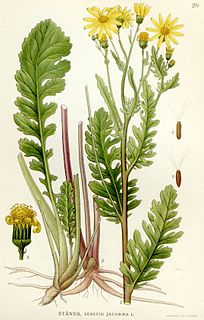
Turtles are an order of reptiles known as Testudines; characterized by a shell developed from their skeleton. Modern turtles are divided into two major groups, the side-necked turtles and hidden neck turtles which differ in the way the head retracts. There are 360 recent species of turtles, including tortoises and terrapins, and they are widely distributed across the world's continents and oceans. Turtles are classified as amniotes, along with other reptiles, birds, and mammals. Like other amniotes, they breathe air and do not lay eggs underwater, although many species live in or around water. Genetic evidence typically places them in close affinity with crocodilians and birds.

Caterpillars are the larval stage of members of the order Lepidoptera.

In botany, an evergreen is a plant which has foliage that remains green and functional through more than one growing season. This also pertains to plants that retain their foliage only in warm climates, and contrasts with deciduous plants, which completely lose their foliage during the winter or dry season.

Jacobaea vulgaris, syn. Senecio jacobaea, is a very common wild flower in the family Asteraceae that is native to northern Eurasia, usually in dry, open places, and has also been widely distributed as a weed elsewhere.

Senecio vulgaris, often known by the common names groundsel and old-man-in-the-spring, is a flowering plant in the daisy family Asteraceae. It is an annual herb, native to Europe and widely naturalised as a ruderal species in suitable disturbed habitats worldwide.

The Arctiinae are a large and diverse subfamily of moths with around 11,000 species found all over the world, including 6,000 neotropical species. This subfamily includes the groups commonly known as tiger moths, which usually have bright colours, footmen, which are usually much drabber, lichen moths, and wasp moths. Many species have "hairy" caterpillars that are popularly known as woolly bears or woolly worms. The scientific name Arctiinae refers to this hairiness. Some species within the Arctiinae have the word "tussock"' in their common names because they have been misidentified as members of the Lymantriinae subfamily based on the characteristics of the larvae.

The cinnabar moth is a brightly coloured arctiid moth found as a native species in Europe and western and central Asia then east across the Palearctic to Siberia to China. It has been introduced into New Zealand, Australia and North America to control ragwort, on which its larvae feed. The moth is named after the red mineral cinnabar because of the red patches on its predominantly black wings. The species was first described by Carl Linnaeus in his 1758 10th edition of Systema Naturae. Cinnabar moths are about 20 mm (0.79 in) long and have a wingspan of 32–42 mm (1.3–1.7 in).
Habitat destruction is the process by which a natural habitat becomes incapable of supporting its native species. The organisms that previously inhabited the site are displaced or dead, thereby reducing biodiversity and species abundance. Habitat destruction is the leading cause of biodiversity loss.

Nosema is a genus of microsporidian parasites. The genus, circumscribed by Swiss botanist Karl Wilhelm von Nägeli in 1857, contains 81 species. Most parasitise insects and other arthropods, and the best-known Nosema species parasitise honeybees, where they are considered a significant disease by beekeepers, often causing a colony to fail to thrive in the spring as they come out of their overwintering period. Eight species parasitize digeneans, a group of parasitic flatworms, and thus are hyperparasites, i.e., parasites of a parasite.

The Saturniinae or saturniines are a subfamily of the family Saturniidae. They are commonly known as emperor moths or wild silk moths. They are easily spotted by the eyespots on the upper surface of their wings. Some exhibit realistic eye-like markings, whilst others have adapted the eyespots to form crescent moon or angular shapes or have lost their wing scales to create transparent windows. They are medium to very large moths, with adult wingspans ranging from 7.5 to 15 cm, in some cases even more. They consist of some of the largest groups of Lepidoptera like the moon or luna moth, atlas moth, and many more. The Saturniinae is an important source of wild silk and human food in many different cultures.

Longitarsus jacobaeae is a species of flea beetle known as the tansy ragwort flea beetle. It is used as an agent of biological pest control against the nectar-rich noxious weed known as ragwort reclassified as Jacobaea vulgaris
The World Register of Marine Species (WoRMS) is a taxonomic database that aims to provide an authoritative and comprehensive list of names of marine organisms.

Tyria is a genus of tiger moths in the family Erebidae erected by Jacob Hübner in 1820. It includes one species: Tyria jacobaeae.

Rothschildia jacobaeae is a moth of the family Saturniidae first described by Francis Walker in 1855. It is endemic to Argentina and Brazil.

Rothschildia is a genus of moths in the family Saturniidae first described by Augustus Radcliffe Grote in 1896.
iNaturalist is a social network of naturalists, citizen scientists, and biologists built on the concept of mapping and sharing observations of biodiversity across the globe. iNaturalist may be accessed via its website or from its mobile applications. As of February 2021, iNaturalist users had contributed approximately 66 million observations of plants, animals, fungi, and other organisms worldwide, and around 130,000 users were active in the previous 30 days.
Botanophila seneciella, the ragwort seed fly or ragwort seed head fly, is a fly species in the family Anthomyiidae.
Nithecus is a genus of true bugs belonging to the family Lygaeidae.














